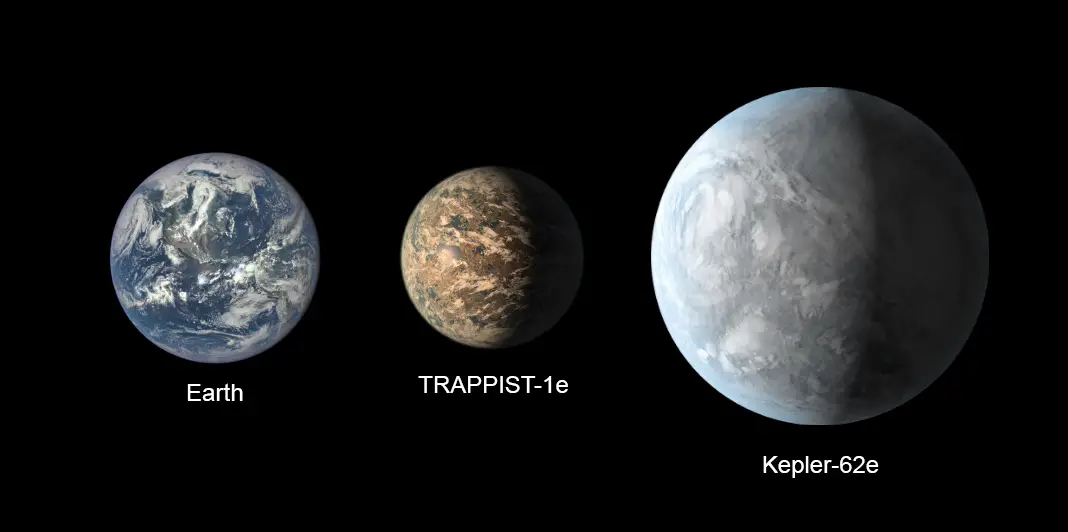For many years, humanity has been searching the stars and asking ourselves if there are any other Earths out there, filled with life just like ours. Well, we still don’t have an answer to that question, but we are now beginning to find more and more stars which seem to have at least one planet orbiting them. While we haven’t found a planet that matches up with our own yet, it seems that this might not be too far off in the future!
Kepler-186f
NASA’s Kepler space telescope has discovered two planets orbiting the same star, and one of them, Kepler-186f, is in what scientists call the habitable zone. The planet could have liquid water on its surface and an atmosphere. It’s too early to tell whether life exists there, but it shows that we’re making progress in our search for other Earths. But even if we find a similar planet, humans will need decades to prepare their voyage. Will they be willing to wait long enough? What if something catastrophic happens here on Earth before then? What are the risks inherent in traveling so far from home? What are the chances of finding another planet with intelligent life? And how would they communicate with these new beings who may not speak any language remotely like ours? So many questions still need to be answered about this planet we’ve only just found. Until then, humankind will have to content themselves with glimpses of hope from outer space as they continue their search for other Earths.
In May, astronomers announced that Nasa’s Kepler space telescope had discovered two planets orbiting within a single system about 200 light years away from Earth. One of those worlds was named Kepler 186f, which orbits its parent star every 130 days at a distance of 1.5 million miles – the equivalent of 10 times closer than Mercury’s orbit around our sun. As such, it falls into the habitable zone – where conditions are believed to be good for life as we know it to evolve and thrive – leading some experts to believe Kepler 186f could contain liquid water and some form of breathable atmosphere. We cannot determine whether life actually does exist on Kepler 186f yet, said Abel Mendez, director of the Planetary Habitability Laboratory at the University of Puerto Rico. What we can say is that all the right ingredients seem to be present.
Gliese 667Cc
The search continues for other habitable planets, and scientists have been narrowing their search to planets in the Goldilocks Zone. Gliese 667Cc is a red dwarf star that is 12 light years from Earth, with at least three planets orbiting it. The third planet, Gliese 667Cc e, orbits within the habitable zone of its star, which means there could be liquid water on its surface. It’s also the only planet out of the three that has not been proven to not harbor life. Scientists hope future missions will help them figure out if this planet does, in fact, have life! They are trying to do so by sending probes and satellites up into space in order to examine any atmosphere they might have as well as taking spectra readings. In order to be able to study the atmosphere, they would need telescopes such as HAWK-I (the High Resolution Airborne Wideband Camera).
While looking through pictures taken by HAWK-I, the team found some anomalies that could represent clouds or possibly oceans, but until further research can take place these speculations are just guesses. Another way scientists are hoping to find life on the planet is by examining Gliese 667Cc f, one of the two moons orbiting Gliese 667Cc. By studying how much radiation it gets compared to our moon and examining its density, they may be able to determine if it has an atmosphere like ours or not. After all of these discoveries we finally know that at least one planet around Gliese 667Cc might actually have potential for sustaining life!
Ross 128b
In November 2017, a team of astronomers made headlines when they discovered what may be our closest Earth-like neighbor. The exoplanet was found orbiting a nearby red dwarf star known as Ross 128, and it seems to have the right conditions to harbor life. It is tidally locked, with one side always facing its sun, which means that one side would likely be much hotter than the other. However, it has an atmosphere that could help cool down its hot side by trapping some of the heat. And Ross 128b is closer in size to Earth than Proxima b, making it more likely that we might find life there someday. But before we start packing up our things, let’s make sure this planet is habitable first! For starters, it orbits a smaller and cooler star. That means that any water on the surface is less likely to evaporate into space and leave behind dry land (a very big problem on planets around larger stars). Second, this planet lies within its parent star’s habitable zone where temperatures are just right for liquid water to exist—another prerequisite for life. So far so good! Let’s see if it also has a magnetic field to protect its atmosphere from getting blasted away from solar winds. Let’s also hope that this planet isn’t covered in oceans of methane and ammonia like Titan (the largest moon of Saturn) is. If those aren’t fatal flaws then this could be the closest Earth-like world yet. There’s still a lot more research to do, but I’m excited about this new discovery.
Scientists can now focus their efforts on finding out whether or not this planet is capable of supporting life.
But even if it doesn’t, maybe we can take heart in knowing that these findings indicate that there are probably many worlds out there with similar climates and potential habitats for life.
![]()
